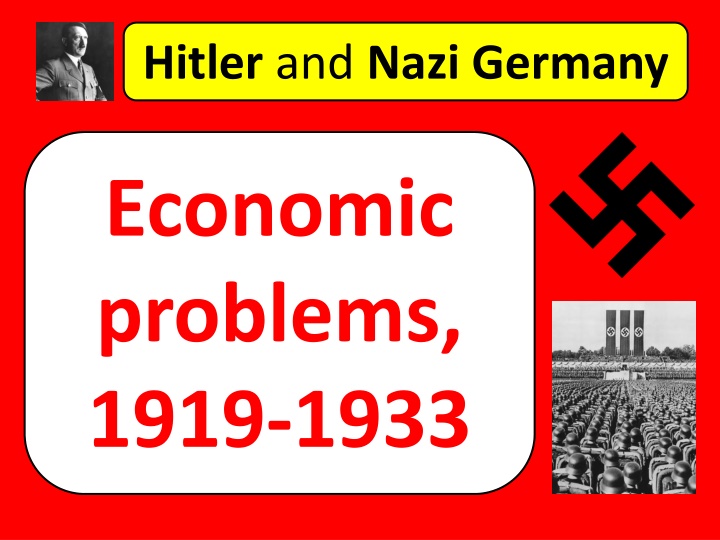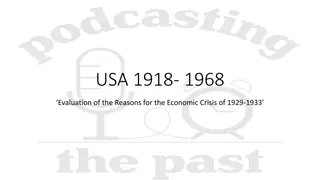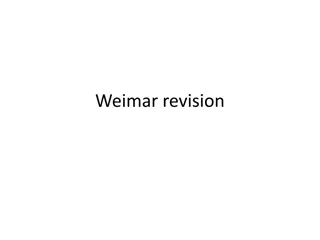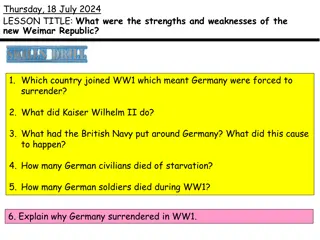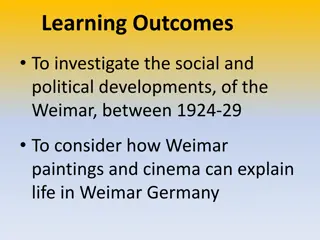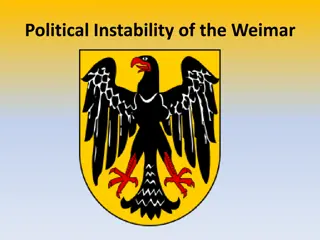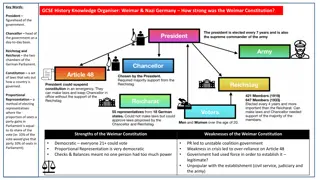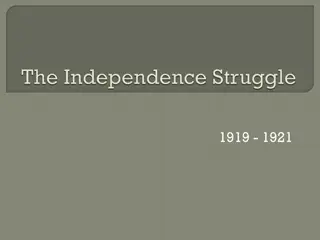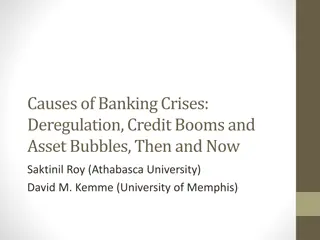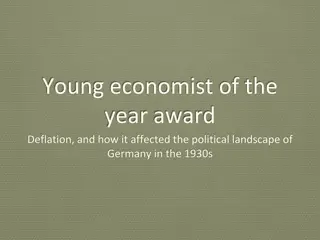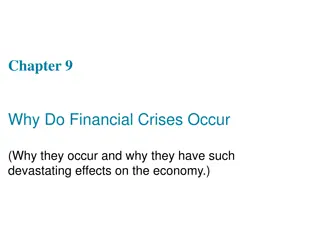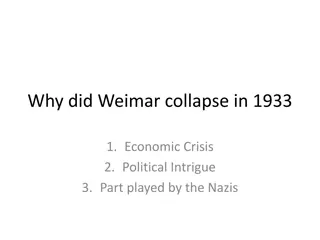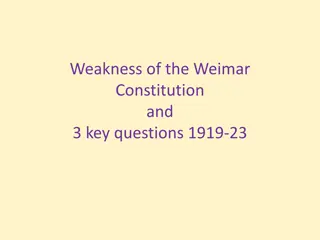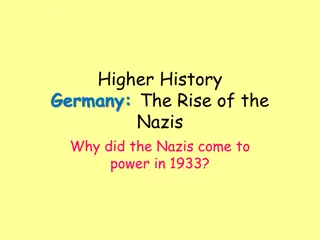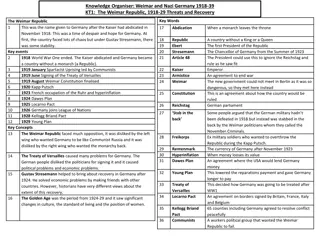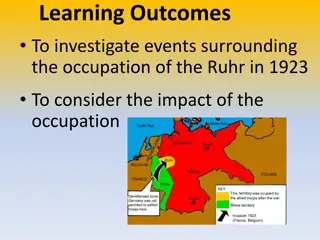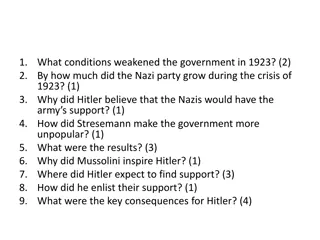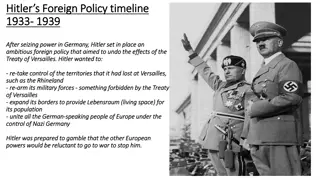Economic Crises Faced by Weimar Republic, 1919-1933
The Weimar Republic encountered significant economic challenges between 1919 and 1933, leading to chaos and a surge in extremist support. Major crises included hyperinflation in 1923 and the devastating global Depression starting in 1929. The Treaty of Versailles imposed reparations on Germany, which struggled to pay, resulting in France and Belgium invading the Ruhr industrial area. Despite not fighting back, the German government ordered workers to strike, exacerbating the economic turmoil.
Download Presentation

Please find below an Image/Link to download the presentation.
The content on the website is provided AS IS for your information and personal use only. It may not be sold, licensed, or shared on other websites without obtaining consent from the author.If you encounter any issues during the download, it is possible that the publisher has removed the file from their server.
You are allowed to download the files provided on this website for personal or commercial use, subject to the condition that they are used lawfully. All files are the property of their respective owners.
The content on the website is provided AS IS for your information and personal use only. It may not be sold, licensed, or shared on other websites without obtaining consent from the author.
E N D
Presentation Transcript
Image result for hitler Hitler and Nazi Germany Image result for nazi swastika Economic problems, 1919-1933 Image result for nazi germany
Image result for hitler Economic problems 1919-33 In today s class, I am learning to: Describe economic crises faced by the Weimar Republic, 1919-1933 Explain why these events caused problems for the Weimar Republic
Image result for hitler Economic problems 1919-33 The Weimar Republic faced various major economic crises that caused chaos all across Germany. These events led to a rise in extremist support.
Image result for hitler Economic problems 1919-33 The first major economic crisis faced by the Weimar Republic was hyperinflation, which in 1923destroyed Germany s economy. Image result for weimar republic hyperinflation An even bigger (and global crisis) started in 1929: the Depression. This also devastated German society.
Image result for hitler Revolts against Weimar Economic crisis Hyperinflation
Image result for hitler Economic problems 1919-33 Image result for treaty of versailles As part of the Treaty of Versailles, Germany had to pay reparationsto the war s victorious countries. Germany struggled to pay the huge sums of money ( 6.6 billion set in 1921), especially given that they were also still trying to rebuild after the war.
Image result for hitler Economic problems 1919-33 When Germany failed to pay reparations to France and Belgium, these two countries invaded the Ruhr. Image result for weimar germany ruhr invasion The Ruhr was Germany s industrial area. France and Belgium planned to take payment in kind - such as coal and steel in place of the reparations.
Image result for hitler Economic problems 1919-33 Germany did not fight back against the invaders. Instead the German government ordered workers to refuse to work with them. Image result for weimar ruhr invasion Ruhr workers went on strike, but the Weimar government kept paying them by simply printing more money.
Image result for hitler Economic problems 1919-33 The more the Weimar government printed money, the less valuable that German money became. Related image Inflation is when prices rise and money loses its value. In Germany in 1923 prices were up massively and very quickly: this is called hyperinflation.
Image result for hitler Economic problems 1919-33 Image result for weimar republic hyperinflation graph The impact of hyperinflation was absolutely devastating. At the start of World War One, the exchange rate was (roughly) four German marks to one US dollar. By November 1923, the rate was (roughly) four billion German marks to one US dollar.
Image result for hitler Economic problems 1919-33 Money became worthless. Workers rushed from being paid to quickly buy food before it became too expensive. Image result for weimar republic economic problems People would burn money instead of firewood, use money to wallpaper their house, or let children play with it like a toy.
Image result for hitler Economic problems 1919-33 Many Germans saw the value of their life savings completely wiped out. Image result for money clipart Germans on fixed incomes (such as pensioners and war widows) could not afford to pay for things, and often starved, became homeless or could heat their homes.
Image result for hitler Economic problems 1919-33 A barter economy developed, where people would swap things or provide services in exchange for food or other goods. However some Germans benefitted from hyperinflation, letting them quickly pay off loans or mortgages.
Image result for hitler Economic problems 1919-33 Image result for weimar republic communist party Germans blamed the Weimar government for their problems. Working class Germans turned towards Communist parties. Others wished for a return of a strong, Kaiser- style government and supported groups like the Nazis. Image result for nazi swastik symbol
Image result for hitler Economic problems 1919-33 In November 1923 a new currency was introduced in Germany the Rentenmark. Image result for weimar germany rentenmark This quickly ended the crisis and stabilised prices. However many Germans were still angry at the effects of hyperinflation, and wanted change.
Image result for hitler Revolts against Weimar Economic crisis The Depression
Image result for hitler Economic problems 1919-33 After the devastation of hyperinflation, the German economy eventually improved. The years from 1924 to 1929 are sometimes called Weimar s Golden Years . Support for extremist parties fell during this period, especially the Nazis.
Image result for hitler Economic problems 1919-33 One reason the German economy improved was that they received loans and other help from the USA. Image result for wall street crash However in October 1929 the American economy collapsed during the Wall Street Crash, resulting in global economic problems, including Germany.
Image result for hitler Economic problems 1919-33 Many Germans felt the Depression was even worse than hyperinflation. Image result for weimar republic great depression By 1932 there were six million Germans unemployed. Homelessness, poverty and other problems also increased due to this.
Image result for hitler Economic problems 1919-33 The German government struggled to deal with the economic crisis. Image result for loans clipart They could no longer get loans from the USA (and had to repay some of the loans they d been given). Various governments could not could agree on what action should be taken.
Image result for hitler Economic problems 1919-33 Image result for german communist party Due to the Depression, Germans again turned towards extremist parties. Support for the Communist Party increased, but the Nazis saw the biggest gains. Image result for nazi party They were especially backed by the upper and middle classes that feared the growth of Communism.
Image result for hitler Economic problems 1919-33 Government actions at this time, included reducing public spending and cutting pensions for older people and war widows, all led to German anger. Image result for money clipart Some governments collapsed because they could not agree on actions to fix the problem.
Image result for hitler Economic problems 1919-33 The Nazis promised to improve people s lives. They even opened soup kitchens to feed hungry people. Image result for soup clipart As a result of this the Nazis went from being the Reichstag s smallest party in 1928 to the largest by 1932. Hitler became German Chancellor in January 1933.
Image result for hitler Economic problems 1919-33 Image result for ajp taylor nazi germany Many historians believe the Depression was the key factor which led to the Nazis taking power. AJP Taylor said that the Depression put the wind in Hitler s sales . William Carr said it was inconceivable that the Nazis would have gained power without it. Image result for William Carr nazi germany
